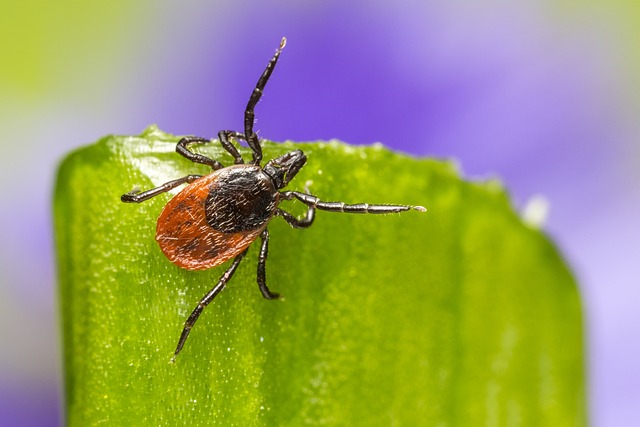Understanding tick behavior is crucial for outdoor tick prevention. Ticks breed in moist, shady areas with dense vegetation, so maintaining yards by removing dense foliage and using natural barriers significantly reduces their habitats. Expert inspectors identify breeding spots and hiding areas, providing insights for strategies like landscape management and tick repellents. By pinpointing key breeding grounds through advanced techniques, professionals guide property owners to minimize risk of tick-borne diseases. Effective outdoor tick prevention includes measures like removing standing water, mowing grass regularly, installing deer fences, and maintaining outdoor spaces.
In the realm of outdoor tick prevention, understanding where these parasites breed and hide is paramount. Ticks, with their intricate life cycles and diverse habitats, pose a year-round threat. Expert inspections play a pivotal role in identifying tick breeding areas, from wooded lots to grassy fields. This article delves into the science behind tick behavior, highlights the expertise of professional inspectors, explores identification techniques, and provides strategies for effective outdoor tick prevention post-inspection.
Understanding Tick Behavior: Where They Breed and Hide
Understanding the behavior of ticks is a crucial step in their prevention and control. Ticks are external parasites that primarily breed and thrive in moist, shady areas with ample vegetation. They often attach to hosts like small animals, birds, or even humans, seeking warm-blooded creatures to feed on. During the day, adult ticks tend to hide in tall grass, under leaves, or within crevices of bark, waiting for a suitable host to pass by. They are less active during warmer months when humidity levels are high, but their populations can surge in late summer and fall as they prepare for winter dormancy.
Identifying these breeding and hiding spots is essential for effective outdoor tick prevention. Regularly maintaining yards and gardens by removing dense vegetation, trimming trees, and clearing debris can significantly reduce tick habitats. Additionally, using natural barriers like plants with repellent properties or applying permethrin-based treatments to outdoor areas can help deter ticks from establishing their populations. These proactive measures are key to minimizing the risk of tick bites and related diseases for both humans and pets in outdoor settings.
The Role of Expert Inspectors in Outdoor Tick Prevention
Expert inspectors play a pivotal role in outdoor tick prevention by employing specialized knowledge and skills to identify potential breeding and hiding areas. Their thorough inspections go beyond what an untrained eye might spot, as they look for subtle signs of tick activity, such as larvae or nymphs, that could indicate established colonies. With their extensive experience, these professionals can assess factors like vegetation density, terrain, and local wildlife presence, all of which contribute to tick habitats.
By conducting these inspections, expert inspectors provide crucial insights for effective outdoor tick prevention strategies. They help property owners and managers implement targeted measures, such as appropriate landscape management, application of tick repellents, and the use of animal companions trained to detect ticks. This proactive approach not only minimizes the risk of human exposure to ticks but also protects pets and local ecosystems from these potentially harmful parasites.
Identification Techniques for Tick Breeding Areas
Identifying tick breeding areas is a crucial step in effective outdoor tick prevention. Expert inspectors employ advanced techniques to pinpoint where these microscopic pests are most likely to thrive. One method involves visually examining the environment for signs of tick activity, such as patches of high grass or brush, which often serve as protection and shelter. Ticks also tend to congregate near habitats with moisture, as they require humidity to survive. By mapping out these areas and understanding the specific microclimates that favor ticks, professionals can implement targeted strategies to mitigate their presence.
Additionally, inspectors may use specialized equipment like handheld UV lights or black light flashlights to detect ticks and their eggs. Ticks emit a faint glow under certain types of light, making them easier to spot. These techniques, combined with knowledge of local tick species behaviors and life cycles, enable experts to identify key breeding grounds. This information is invaluable for property owners and land managers aiming to minimize the risk of tick-borne diseases by implementing appropriate outdoor tick prevention measures.
Implementing Effective Strategies Post Inspection
After a thorough expert inspection, the next crucial step is implementing effective strategies for outdoor tick prevention. This involves addressing the identified tick breeding and hiding areas to disrupt their lifecycle and reduce potential exposure. Homeowners and property managers should prioritize removing standing water, as ticks require moisture for reproduction, and mow grass regularly to minimize their habitats.
Additionally, installing physical barriers like deer fences can help keep wildlife, which often carries ticks, away from residential areas. Regular cleaning and maintenance of outdoor spaces, including washing pet beds and grooming pets after outdoor activities, are essential practices in the fight against tick populations. These measures not only promote a safer environment but also contribute to long-term outdoor tick prevention.
Expert inspections play a pivotal role in outdoor tick prevention by identifying breeding and hiding areas, enabling effective strategies to mitigate these tiny but dangerous vectors. Understanding tick behavior and employing advanced identification techniques ensure targeted interventions. Post-inspection, implementing evidence-based strategies significantly reduces the risk of tick-borne diseases, contributing to healthier outdoor environments and communities.
